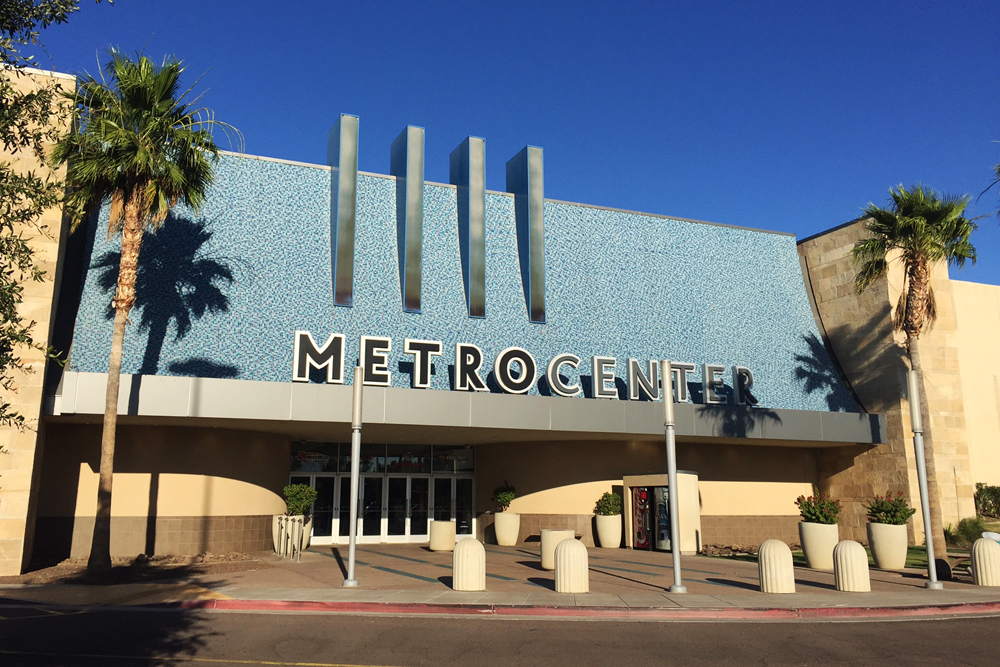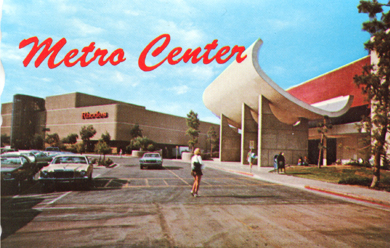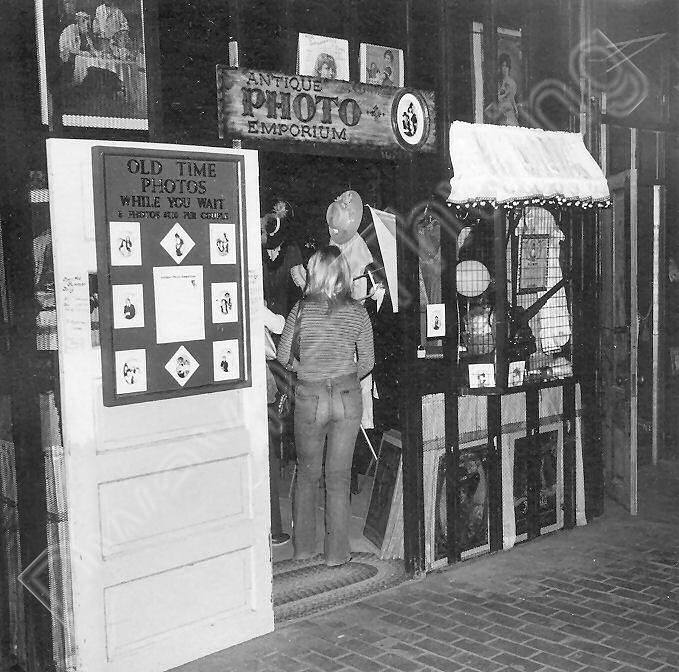|
The Joan De Arc

All the fits that's news to print |
Phoenix, Arizona / Sunday, June 18, 2017
Founded AD 1968 / $10.00
© 2017 by JPB Publishing Ltd.
Avenue Weather: Partly cloudy with possible late afternoon showers. High
111 / Low 81
On the INSIDE:
Editorials A2
/ Entertainment
A3 /
Nostalgia
A4
/
Crossword A5
HAPPY FATHERS DAY
_____________________________________________________________

Walmart coming to Metro
(BP)
– Construction is winding down for the new Walmart Supercenter at
Metrocenter, which is expected to open later this summer.
Ground was broken last July 20 for the 148,000-square-foot store,
which represents by far the largest capital investment made in the
44-year-old mall in decades. The store will occupy the site of the
old Broadway department store building, which was demolished last
year after being vacant since 2006. The new Walmart is expected to employ around
250 workers in part and full-time positions.
Metrocenter is currently in the midst of a major revitalization
plan. Last summer, the Phoenix City Council approved zoning changes
that allow for new office space, senior housing, multi-family
housing and healthcare facilities. The Walmart center is seen as the
first step in the long-term rehabilitation of the once popular mall.
Warren Fink, COO of Carlyle Development Group, said “our vision when
we acquired Metrocenter mall two-and-a-half years ago was to bring
in a well-known anchor to serve our local community. Walmart more
than fulfills that requirement and we are thrilled to welcome them.”
Metrocenter mall, about two miles
southeast of Joan De Arc Avenue, first opened in 1973.
The rise and fall (and rise?) of Metrocenter
Analysis
by J. Bueker
My quintessential memory of that patch
of land south of Peoria Avenue along the Black Canyon Freeway is,
without a doubt, the smell; that remarkably disagreeable odor that,
50 years hence, still lingers in my nostrils like an eternal miasma
dispersed and wafting through my childhood recollection. It was the
kind of stink that could only be generated by a rather sizable field
of broccoli baking beneath the heat of the central Arizona sun.
The malodorous veggie field was quite impossible to ignore. After
all, our family encountered it each and every time we ventured down
the freeway. It was a sort of Van Allen radiation belt of stench
through which one was forced to pass on the way to any worthwhile
destination south of Surrey Heights. Rolling up the car windows did
little to mitigate the pervasive fragrance, which would dissipate
only with the passage of time and a suitable distance away from the
contaminated area. But pass through it we did, on virtually a weekly
basis throughout the 1960s.
By 1970
however, ambitious plans had been laid for the smelly old broccoli
field; very ambitious plans indeed. A shopping mall of unprecedented
scope and splendor would rise upon this pungent parcel of
agricultural soil, and so the old broccoli patch soon disappeared
into Phoenix history, like so many other thousands of acres of
cropland that yielded to the ever-encroaching behemoth of Phoenix
civilization during that era.
I think
it’s worthwhile remembering that a humble and putrid old field of
cruciferous vegetables is where Metrocenter mall was born. That such
a lamented and unlikely parcel of real estate very near Joan De Arc
Avenue would be transformed into one of the largest shopping centers
on earth was no trivial matter. How could we have even conceived of
such a possibility as we sped past the fetid rows of broccoli during
our early journeys south? We were about to have a world-class mall
plopped down in practically our very own backyard.
We had never seen anything remotely like it. Metrocenter boasted 1.4
million square feet of space and was the first two-story mall to
appear in Arizona. There were no fewer than five major anchors
situated around its periphery: Sears, Rhodes, Diamonds, Goldwater’s
and Broadway. There was a full-sized Ice Capades Chalet skating
rink, multiple movie theatres and restaurants, a countless myriad of
specialty shops, and a sleek drinking establishment called Metro
Port Lounge, which overlooked the ice rink and was designed inside
and out to resemble a jet airliner. It was here I first experienced
the timeless rite of passage of being carded and then kicked out of
a bar. Oh, but I would be back.
Colossus
that it was, the mall proper was only one component of the overall
development at Metrocenter. The primary shopping center was enclosed
within a ring of paved roadway that was framed by a second outer
concentric ring built to accommodate even more businesses along with
a variety of residential construction. The result of it all was a
mile-long shopping mall development that filled the entire space
between Peoria and Dunlap Avenues.
The
original architectural flavor of Metrocenter was uniquely eclectic.
Like our beloved Christown, Metro was infused with its own unique
architectural identity, but one quite different from the futurist
Googie flair of the older mall. Put briefly, Metro’s design was
ultra-modern with some very curious exotic influences thrown into
the mix.
Perhaps the most memorable of
these influences came from the far side of the planet. Metrocenter
architect Robert Fairburn apparently harbored a deep admiration for
the legendary architect Le Corbusier and his Palace of Assembly, a
rather astonishing building constructed in the city of Chandigarh,
India in the 1950s. Fairburn incorporated certain aspects of that
structure’s unique design into his vision for the new mall. Most
notably, he chose to adorn each of the mall entrances with a huge
wave of soaring concrete held in place by a trio of towering
parabola-shaped buttresses. The result was a uniquely equivocal
architectural effect, yet one that meshed beautifully in the overall
design.
One of the more charming
features of the original mall was an eccentric little concourse
called “The Alley,” which was located in a rather obscure area on
the upper level near Sears. Decorated to resemble a narrow
city alleyway, the passage conveyed an odd sort of hippie vibe and
incorporated a few small businesses into its tableau, including a
Lotions ‘n’ Potions shop and antique photo emporium. However, for
the most part, The Alley served no apparent purpose whatsoever; it
was the kind of absolutely frivolous adornment that lends true
character and distinction to a shopping institution. So of course,
it didn’t last.
The funny thing about
shiny new shopping malls is that they inevitably fall into decline.
Exactly when this fate befell Metrocenter is of course a matter of
subjective perception, but some of the iconic businesses disappeared
surprisingly quickly. The skating rink was closed in a mall
renovation in 1986, after only a dozen years of existence, with
Metro Port Lounge likewise disappearing at this time. The resulting
cavernous empty space was eventually filled with a food court above
and a large video arcade below.
In
1993, Arrowhead Mall opened in Glendale and began luring business
away from Metrocenter in much the same manner as Metro had once done
to Christown mall. Of the original five anchors at Metro, only Sears
and Diamonds (Dillards) now remain, the latter relegated to the
diminished status of “clearance center” and utilizing only the upper
level of the store. On my infrequent visits there, I cannot help but
reminisce about waiting in long lines for Phoenix Suns tickets
during their epic 1976 playoff run. The Diamonds box office of
course is now long gone.
A few of the
original architectural flourishes at Metrocenter have managed to
endure. A prime example is the Western Savings building, with its
distinctive rising cone-shaped, ribbed tower. The bank building
lives on as a Souper Salad restaurant with a distinctly different
color scheme from the original structure. Sadly, the iconic concrete
entrance slabs at Metro were removed in a $32 million mall facelift
in 2004. I wonder what they did with the things.
When contemplating the future of Metrocenter, it’s perhaps
instructive to review the mall’s parallels with Christown. Both
malls were prime Phoenix shopping destinations that fell into
decline amid changing neighborhood demographics and the strain of
competition with newer malls. No small irony lies in the fact that
Christown, whose prosperity was deeply affected by the opening of
Metrocenter in 1973, has managed to survive and could conceivably
outlive its long-time rival.
In a sad
and eerie reenactment of Christown’s past, Metrocenter recently
demolished its old Broadway store building to make room for a new
Super Walmart. This certainly signals that the old mall will
continue to be a shopping destination of sorts, although some local
residents argue that the addition of a Walmart will hasten the
demise of the once great Metrocenter rather than inhibit it. Time
will tell.
Ultimately, the fate of Metro
may more resemble that of Park Central than Christown: a
hybrid blend of stores, restaurants, office space, healthcare
facilities and residential property. This destiny also appears to be
the plan for Fiesta Mall in Mesa.
One
reason for optimism regarding Metrocenter’s future is the Metro
Light Rail, which will soon be making its way west from 19th Avenue
along Dunlap Avenue to the mall, ensuring a resurgence of patrons in
the years ahead, just as it has for Christown Spectrum. This should
breathe new life into the once invincible shopping mecca on Peoria
Avenue.
And so, while Metrocenter’s
finest days are certainly well confined to its past, there now seems
at least a smidgen of hope that the senescent mall’s deteriorating
condition may at least stabilize in the years ahead. Regardless of
what transpires, I am quite satisfied that Metrocenter will continue
to be a stellar improvement over that foul-smelling broccoli field
of my Phoenix childhood. If all else fails, it’s got that going for
it.
___________________________________________________________________________________________________________________JDA
On the INSIDE:
Editorials A2
/ Entertainment
A3 /
Nostalgia
A4
/
Crossword A5
Moon Phases:
 New:
June 23
New:
June 23
 First Quarter: June 30
First Quarter: June 30
 Full:
July
9
Full:
July
9
 Last Quarter:
July 16
Last Quarter:
July 16
|



